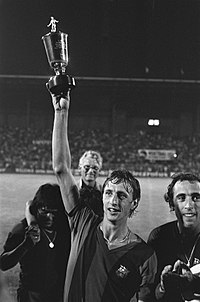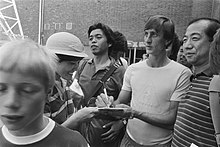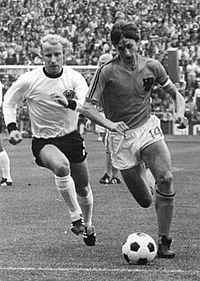Johan Cruyff
Hendrik Johannes "Johan" Cruyff (![]() ; anglicised from Cruijff; * 25 April 1947 in Amsterdam, Netherlands; † 24 March 2016 in Barcelona, Spain) was a Dutch football player and coach, as well as an official and consultant in the sport of football.
; anglicised from Cruijff; * 25 April 1947 in Amsterdam, Netherlands; † 24 March 2016 in Barcelona, Spain) was a Dutch football player and coach, as well as an official and consultant in the sport of football.
He won the Dutch championship nine times (1965/66, 1966/67, 1967/68, 1969/70, 1971/72, 1972/73, 1981/82, 1982/83, 1983/84), the Dutch Cup six times (1966/67, 1969/70, 1970/71, 1971/72, 1982/83, 1983/84) and the Intertoto Cup once (1968). He also won the European Champion Clubs' Cup three times (1971, 1972, 1973), as well as the European Supercup twice (1972, 1973) and the World Cup once (1972). With FC Barcelona he won the Spanish Championship (1973/74) and the Spanish Cup (1977/78).
He captained the Dutch national team to second place in the World Cup (1974) and third place in the European Championship (1976).
He was twice top scorer in the Netherlands (1966/67 and 1971/72). Cruyff was also named European Footballer of the Year three times (1971, 1973, 1974), Spain's Best Foreign Player twice (1977, 1978), and NASL Player of the Year once each (1979) and Netherlands Footballer of the Year (1984). He was named Europe's Footballer of the 20th Century in 1999. He was also included in Pelé's FIFA 100 list. He was considered a gifted playmaker and was the poster boy of Dutch football. Cruyff was the star of "total football" (totaalvoetbal).
As a coach, he won the Dutch Cup twice (1986, 1987) and the European Cup Winners' Cup once (1987) with Ajax Amsterdam. At Barcelona, he shaped the youth academy La Masia, initiated by Rinus Michels, and formed the "Dream Team" that won the European Cup of Champions for the first time in 1992. He also won the Spanish championship four times with FC Barcelona (1990/91, 1991/92, 1992/93, 1993/94) as well as the Spanish Cup (1990), the UEFA Super Cup (1992) and the European Cup Winners' Cup (1989) once each.
Club career
Beginnings in football
Hendrik Johannes Cruijff lived in his youth only a few minutes to the stadium De Meer, where the football club Ajax Amsterdam played its home games. The boy from a humble background quickly made the decision to become a footballer and joined the Ajax youth section at the age of twelve. There the young players were treated and trained according to the English model and soon the sport determined his entire daily routine. His father had passed away in 1959 and Cruijff immersed himself in his mother's workplace after school at Ajax Amsterdam. He listened in on the players' conversations and learned that there was money to be made in football, which reinforced his desire to turn professional. Ajax coach Vic Buckingham recognized Cruyff's talent, but also the skinny boy's shortcomings, lack of strength, and forced him into muscle-building training. It wasn't until he was 15 that he was able to take a corner kick in front of goal.
Ajax Amsterdam (1964 to 1973)
On 15 November 1964, the 17-year-old Cruyff made his first league (Eredivisie) debut for Ajax Amsterdam. He scored his team's only goal in a 3-1 defeat to GVAV Groningen (FC Groningen since 1971).
The following season, 1965/66, Cruyff became a professional player (his monthly salary was 120 guilders), but there was little enthusiasm for the talent in the boardroom. Weighing just 60 kilograms, he was still considered too slight, but above all the officials disliked Cruyff's public consumption of cigarettes.
When Rinus Michels became the new head coach in January 1965, a new era began for Ajax Amsterdam and Johan Cruyff. The new coach believed in the attacking all-rounder's abilities, made him a regular player and groomed Cruyff with daily strength exercises and runs in the woods. Michels completely overhauled the club's structures when he introduced training camps and the full-time professional, practised team-building with an iron hand and revolutionised tactics. He developed the concept of Voetbal Totaal: aggressive pressing and constant formation changes. He wanted the whole team to get involved in the attacking play and thus put the opponent under pressure. Tactically, the coach was an advocate of the attacking 4-3-3 system. The focal point of this model was Johan Cruyff, who was nominally a centre-forward, but who appeared all over the pitch and acted as playmaker, goal-scorer and crosser. Elegant and fleet-footed, the exceptional player was the link between coach and team, perfectly implementing Michel's tactical instructions on the field. Even today, the timing of his passes is considered elusive, prompting one English journalist to write that he played like the "Pythagoras of football".
He won the championship title with Ajax in 1966. The Voetbal Totaal was something completely new and sometimes presented opponents with insurmountable tasks. Cruyff won the championship six times and the national cup four times with Amsterdam from 1966 to 1973. The names of players like Johan Neeskens, Arie Haan, Ruud Krol, Johnny Rep or Piet Keizer stood for this new way of playing football. But the unrivalled superstar was Johan Cruyff.
After hip surgery in the spring of 1970, Cruyff was not able to play again until 30 October 1970 against PSV Eindhoven. In this match he wore his legendary shirt number 14 for the first time, because his teammate Gerrie Mühren occupied Cruyff's usual number 9. From then on he only wore 14.
Voetbal Totaal also made its mark on the international stage: In 1969, Ajax lost 4-1 to AC Milan in the final of the European Champion Clubs' Cup, but two years later they beat Panathinaikos Athens to take the European football crown. Previously second-rate Dutch football had awoken from its slumber.
Even when coach Michels moved to FC Barcelona after this triumph, the successes did not stop. Under successor Ștefan Kovács, the team won the European Cup twice in a row, beating Inter Milan 2-0 in 1972 (both goals by Cruyff) and Juventus Turin 1-0 in 1973. Ajax was the world's best club team, winning the European Super Cup (1972 and 1973) and the 1972 World Cup against Independiente Avellaneda. Since the "royals" of Real Madrid, no team had dominated Europe's football like Amsterdam under "King Johan", who was European Footballer of the Year in 1971, 1973 and 1974.
Transfer to FC Barcelona (1973)
In the summer of 1973, the Spanish league opened its borders to foreign professionals. Barça coach Michels wanted to sign his star pupil in order to import his football philosophy. This request did not fall on deaf ears at Ajax. The Cruyff-Ajax relationship was disturbed. New coach Georg Knobel had the captain elected by the team, and the lesser players in the squad chafed at the arrogant dominance of the superstar. They voted him out and appointed Piet Keizer as the new captain, making it clear to the offended Cruyff that he wanted to change clubs. The board did not stand in the way of this plan, as a considerable transfer fee was in the offing and they believed they were strong enough without Cruyff.
Cruyff's manager, father-in-law Cor Coster, represented the star in the transfer negotiations and engineered the biggest transfer in football history to that point. For the transfer fee of DM 3.7 million, Cruyff moved to FC Barcelona, who paid him DM 2.35 million (plus bonuses) for three years and provided a service villa. The player himself explained that he had chosen the Catalans over Real Madrid because he could not play for a club associated with the Spanish dictator Franco.
After the Dutch association KNVB had finally given its approval (Cruyff had threatened to end his career in the meantime if they did not let him move to Spain), Cruyff arrived in Barcelona in October 1973.
FC Barcelona (1973 until 1978)
Due to transfer problems, Cruyff did not feature for Barça until matchday 7 of the 1973/74 season, when they were second-last in the table. On 28 October 1973, he played his first league game against Granada FC and scored twice in a 4-0 win. Cruyff's game was tailor-made for the Catalan mentality and the team. The turnaround was on and his debut was to be the start of a run of 24 unbeaten games (18 wins, six draws). The Dutchman's changes of pace, variety and creativity revitalised Barça's play and they were soon top of the table. The crowning glory finally came in February 1974, when Real Madrid were humiliated 5-0 by Barcelona at the Estadio Santiago Bernabéu. The Catalans also celebrated this triumph as a victory over Franco's centralist Spain. A veritable "Cruyffmania" ensued, and he advanced to become Catalonia's national hero. The fans nicknamed him El Salvador (The Redeemer). At the end of the season, Barça won the championship for the first time in 14 years, and Cruyff was named "Europe's Footballer of the Year" for the third time.
During his time at Barcelona, he scored the so-called phantom goal. During the match against Atlético Madrid, Cruyff jumped in the air and scored the goal with his right heel (although the ball already reached neck height) without seeing the ball.
But this high-flying period did not last long. Cruyff was joined by Johan Neeskens, his congenial partner from the Ajax days, but the pair were unable to win another championship. A resurgent Real Madrid once again dominated Spanish club football, and Cruyff had to settle for three runner-up finishes. When Hennes Weisweiler became the new coach for the 1975/76 season, he clashed with Cruyff time and again. The German would not tolerate another star beside him and accused Cruyff of not doing enough for the defence in away games, so he banished him to the bench. After the championship season, the star had taken it easy, training less and smoking more, but the fans sided with him and in the end Weisweiler had to go. Under pressure from Cruyff, Rinus Michels returned to the bench. In 1978, the maverick Dutchman won the Copa del Rey with FC Barcelona before surprisingly retiring from the game.
Cruyff's farewell match was played at Camp Nou on 28 May 1978. He played one half each for Ajax Amsterdam and FC Barcelona. Another farewell match between Ajax Amsterdam and FC Bayern Munich on 7 November 1978 became an anecdote for football history and a debacle for the Dutch. Bayern, feeling badly treated by their hosts, were highly motivated and won what was supposed to be a friendly 8-0.
Los Angeles Aztecs and Washington Diplomats (1979 to 1981)
Cruyff reappeared on the football scene out of nowhere in early 1979 when he signed a well-paid contract with the Los Angeles Aztecs. Cruyff followed the likes of Franz Beckenbauer, Gerd Müller, Giorgio Chinaglia and George Best into the North American professional league, the NASL, which had a reputation for being an "operetta league". Here he was voted "NASL Player of the Year", and after a year in Los Angeles he played another season for the Washington Diplomats.
UD Levante (1981)
The Diplomats soon ran into financial difficulties, so the business-minded Cruyff preferred to return to Europe. After a move to English Premier League side LeicesterCity fell through, he instead joined UD Levante (Segunda División) in January 1981. However, injuries and disagreements with the club's management meant that the now 34-year-old only played ten games. When the club failed to win promotion, they were unable to afford the high salary for their star and let him go in the summer of 1981.
Ajax Amsterdam (1981 to 1983)
For the second time, it seemed as if Johan Cruyff's career was over. Even more so when he was introduced to Ajax Amsterdam as 'technical advisor' to coach Leo Beenhakker on 30 November 1981. The football world, however, expected him to soon don the red and white jersey of the Ajacids as a player as well. On December 6, 1981, he made his return. He scored a goal in a 4-1 victory over FC Haarlem. As an experienced playmaker, he led the team back to the top of the league, winning the league title in 1982, and even the "double" in 1983. When the club's management decided not to offer the 36-year-old a new contract, Cruyff was disappointed and moved on to arch-rivals Feyenoord Rotterdam.
Feyenoord Rotterdam (1983/84)
At Feyenoord, Cruyff reached an astonishing top form at the end of his career and played an outstanding season, which was crowned with championship and cup. As a reflection of his achievements, he was honoured with the title of Footballer of the Year of the Netherlands. As a midfield director, he had led the team brilliantly and supported young talents like Ruud Gullit.
On 13 May 1984 he finally ended his career in the match against PEC Zwolle.

Cruyff in the jersey of FC Barcelona (1975)

Johan Cruyff with fans (1982)
.jpg)
Johan Cruyff (1965)
_scoort.jpg)
Cruyff as an Ajax player
Career in the national team
Cruyff's international career began on 7 September 1966, when he drew 2-2 with Hungary in a European Championship qualifier in Rotterdam. His impulsive style of play proved to be his undoing in his second international match, when GDR referee Rudi Glöckner sent him off after 76 minutes against the USSR, making him the first Dutch player to be sent off in an international match. After a one-year ban by the federation, he was not allowed to play again until 13 September 1967. Cruyff was a harsh critic of the KNVB, which he accused of not having participated in a World Cup since 1938 due to a lack of professionalism. He was bothered by the second-class status of the national team. But even the qualification for the 1970 World Cup was not achieved.
It was not until four years later that the Elftal qualified for the 1974 World Cup finals in Germany. Cruyff captained the team to the finals, and when Rinus Michels took over 'Oranje' shortly before the tournament began, the hopes of his compatriots were high. Now the Voetbal Totaal also took hold in the national team and the players who did not come from Ajax Amsterdam had to familiarise themselves with the system. The preliminary round was easily completed as group winners, and the strong Dutch were then among the favourites for the World Cup title. In the second final round, Oranje and Johan Cruyff arguably reached the zenith of their ability. Argentina were beaten 4-0 (two Cruyff goals), East Germany 2-0 and even defending champions Brazil 2-0 (one Cruyff goal). The football world was enthralled by the playful ease of these victories and raved about the Voetbal Totaal. The Netherlands reached the final, where they were considered clear favourites over the DFB team. However, after leading 1-0, the West German team won 2-1 and became world champions. Cruyff himself had taken the penalty for the lead, but in the second half he was almost taken out by man-guard Berti Vogts.
Between 1974 and 1976, the Netherlands played successfully in the qualifiers for the 1976 European Championship, in which four teams took part. They lost the semi-final to Czechoslovakia, but won the third-place match against hosts Yugoslavia.
He played his last international match on 26 October 1977 in Amsterdam in a World Cup qualifier against Belgium (1-0). After he had already ended his international career, Ernst Happel, who was hired by the Dutch Football Association shortly before the 1978 World Cup in Argentina, tried to persuade him to make a comeback at the World Cup, but without success. The exact reasons for this are not known to this day. In the spring of 2008, Cruyff stated in an interview that he had decided not to play in the World Cup because of a kidnapping attempt in which he and his family were threatened with weapons.
In total, Johan Cruyff played 48 international matches, scoring 33 goals and captaining his team 33 times.
He also played twice for the Catalan football team, but did not score any goals.

Johan Cruyff as captain of the Elftal (1974)

Cruyff (right) in the final of the 1974 World Cup against Berti Vogts
Search within the encyclopedia